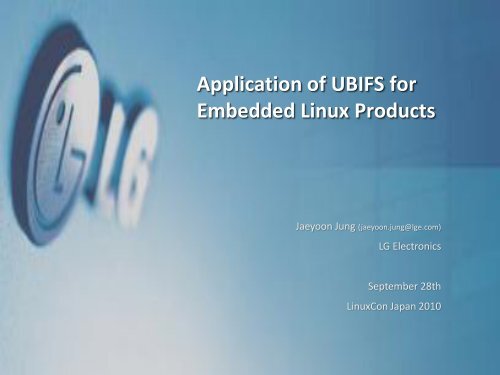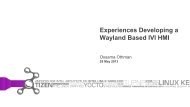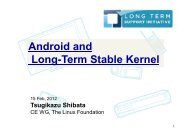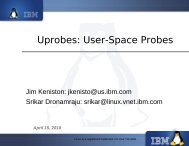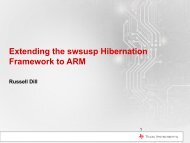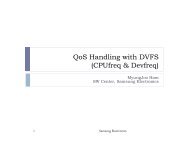Application of UBIFS for Embedded Linux Products - The Linux ...
Application of UBIFS for Embedded Linux Products - The Linux ...
Application of UBIFS for Embedded Linux Products - The Linux ...
You also want an ePaper? Increase the reach of your titles
YUMPU automatically turns print PDFs into web optimized ePapers that Google loves.
<strong>Application</strong> <strong>of</strong> <strong>UBIFS</strong> <strong>for</strong><br />
<strong>Embedded</strong> <strong>Linux</strong> <strong>Products</strong><br />
Jaeyoon Jung (jaeyoon.jung@lge.com)<br />
LG Electronics<br />
September 28th<br />
<strong>Linux</strong>Con Japan 2010
Agenda<br />
• Introduction<br />
• NAND Flash device<br />
– Characteristics <strong>of</strong> NAND flash<br />
– MTD device vs. FTL device<br />
– File systems <strong>for</strong> NAND flash<br />
• UBI and <strong>UBIFS</strong><br />
– Overview <strong>of</strong> UBI and <strong>UBIFS</strong><br />
– Strengths from the embedded systems’ point <strong>of</strong> view<br />
• Mounting time <strong>of</strong> <strong>UBIFS</strong><br />
– Experimental results<br />
• Summary<br />
2
Introduction<br />
• NAND flash memory is one <strong>of</strong> the most common storage devices in the<br />
present embedded systems.<br />
– Low price, large capacity, good per<strong>for</strong>mance<br />
– Some inconvenient characteristics to be managed<br />
• <strong>UBIFS</strong> is the one <strong>of</strong> the best file systems <strong>for</strong> NAND flash.<br />
– I/O per<strong>for</strong>mance, tolerance to power-failure, wear-leveling<br />
– It benefits from UBI which provides the better environment <strong>for</strong> NAND flash.<br />
• Mounting time is one <strong>of</strong> the most important parts.<br />
– It influences on the boot time <strong>of</strong> the embedded system.<br />
– It can depend on the device size, the file system usage and the condition <strong>of</strong><br />
previous un-mounting.<br />
3
NAND Flash Device: Characteristics <strong>of</strong> NAND flash<br />
Bad blocks<br />
Bit-flips<br />
Endurance<br />
Characteristic<br />
NAND flash admits having bad<br />
blocks.<br />
Data can be disturbed by the<br />
influence <strong>of</strong> adjacent cells being<br />
read(read disturb) or<br />
programmed (program disturb).<br />
All blocks have a limited<br />
number <strong>of</strong> erase/program<br />
cycles.<br />
Solution<br />
Manage bad blocks to avoid<br />
using them.<br />
Use ECC to correct disturbed<br />
data.<br />
Refresh the block to reduce the<br />
further bit-flips.<br />
Do the wear-leveling to<br />
distribute the number <strong>of</strong><br />
erasures evenly.<br />
• For MLC NAND flash<br />
– <strong>The</strong> higher level <strong>of</strong> ECC is required due to its higher degree <strong>of</strong> bit-flip.<br />
– <strong>The</strong> wear-leveling is more essential because it has a shorter erase/program<br />
cycle than the SLC type.<br />
4
NAND Flash Device: MTD device vs. FTL device (1/2)<br />
• MTD device<br />
– Common interface <strong>for</strong> flash<br />
devices in <strong>Linux</strong><br />
– Provides the abstraction layer <strong>for</strong><br />
different types <strong>of</strong> bare flash<br />
devices.<br />
MTD layer<br />
NAND flash<br />
MTD device<br />
• FTL device<br />
– Translation layer <strong>for</strong> flash devices<br />
– Requires a controller which<br />
emulates the block device<br />
interface on top <strong>of</strong> the flash.<br />
– Example<br />
• USB flash drive, SD, MMC,<br />
eMMC, SSD, …<br />
Block device layer<br />
FTL controller<br />
NAND flash<br />
FTL device<br />
5
NAND Flash Device: MTD device vs. FTL device (2/2)<br />
Interface<br />
NAND flash<br />
compatibility<br />
Bad blocks,<br />
Bit-flips,<br />
Endurance<br />
MTD (NAND)<br />
Direct interface to NAND<br />
controller (SoC)<br />
Dependent on NAND<br />
controller (SoC)<br />
Not managed<br />
→Upper layer must manage<br />
them.<br />
FTL<br />
Block device interface<br />
(USB mass storage, SD, …)<br />
Dependent on FTL controller<br />
Managed by FTL controller<br />
→Upper layer does not have<br />
to manage them.<br />
File systems JFFS2, YAFFS2, <strong>UBIFS</strong>, … FAT, EXT3, EXT4, …<br />
• Remarks<br />
– In case <strong>of</strong> using FTL device, it is easier to deal with the unexpected change <strong>of</strong><br />
NAND flash due to discontinuity <strong>for</strong> example.<br />
– <strong>The</strong> cost <strong>for</strong> FTL device is a little bit higher due to the FTL controller.<br />
– FTL s<strong>of</strong>tware is vendor-dependent and the code is not open, so it is hard to<br />
verify the problems without help from the vendor.<br />
6
NAND Flash Device: File systems <strong>for</strong> NAND flash<br />
• <strong>Linux</strong> has many file systems <strong>for</strong> bare NAND flash devices which have<br />
good per<strong>for</strong>mance and reliability. Of course, they are open-sourced.<br />
• Read-only file systems<br />
– Read-only, but fast and safe<br />
• Suitable <strong>for</strong> boot partitions<br />
– Even though they are not designed <strong>for</strong> NAND flash, they can run on top <strong>of</strong><br />
MTD with help <strong>of</strong> an additional layer such as ‘romblock’.<br />
– Example: SquashFS<br />
• Read/write file systems<br />
– General purpose<br />
– Supports bad block management, bit-flip handling and wear-leveling.<br />
– Example: JFFS2, YAFFS2, LogFS, <strong>UBIFS</strong><br />
7
UBI and <strong>UBIFS</strong>: Overview (1/2)<br />
• UBI (Unsorted Block Images)<br />
– A sub system that provides consecutive logical eraseblocks which are mapped<br />
to physical eraseblocks.<br />
– Volume management system which manages multiple logical volumes on a<br />
single raw flash device.<br />
– Runs on top <strong>of</strong> MTD.<br />
– Mainlined since kernel version 2.6.22.<br />
• <strong>UBIFS</strong><br />
– A file system <strong>for</strong> flash which works on top <strong>of</strong> UBI over MTD.<br />
– Considered as the next generation <strong>of</strong> JFFS2.<br />
– Mainlined since kernel version 2.6.27, 17 July 2008.<br />
8
UBI and <strong>UBIFS</strong>: Overview (2/2)<br />
• Basic concept <strong>of</strong> UBI<br />
– LEB-to-PEB mapping<br />
• Each PEB has a VID(Volume ID) header which contains a corresponding volume ID<br />
and a LEB number.<br />
• Uses the eraseblock association table in RAM which contains the mapping<br />
in<strong>for</strong>mation.<br />
– Attaching UBI<br />
• Gathering the block mapping and volume in<strong>for</strong>mation by scanning VID headers.<br />
• It must be done be<strong>for</strong>e running a file system on top <strong>of</strong> UBI.<br />
Volume 0 Volume 1<br />
UBI<br />
Logical eraseblocks<br />
MTD<br />
Physical eraseblocks<br />
Free<br />
Allocated<br />
Bad<br />
9
UBI and <strong>UBIFS</strong>: Strengths in the embedded systems (1/3)<br />
• Bad block management (UBI)<br />
– Bad PEBs are hidden and managed by UBI.<br />
– Only non-bad logical eraseblocks are exposed to upper layer.<br />
• Bit-flip handling (UBI)<br />
– Bit-flip can be handled by UBI using ECC.<br />
– Additional management <strong>for</strong> possible bad blocks<br />
• Scrubbing: Moving data from a PEB that has bit-flips to other PEB.<br />
• Torturing: Doing some tests <strong>for</strong> a PEB in order to detect it is really bad.<br />
• Wear-leveling (UBI)<br />
– Dynamic wear-leveling<br />
– Static wear-leveling<br />
– Global wear-leveling<br />
10
UBI and <strong>UBIFS</strong>: Strengths in the embedded systems (2/3)<br />
• Tolerance to power-failure<br />
– Volume table duplication (UBI)<br />
– Atomic LEB change (UBI)<br />
– Both UBI and <strong>UBIFS</strong> can checksum everything when they write data to the<br />
flash. (default, optional)<br />
• On-the-flight compression (<strong>UBIFS</strong>)<br />
– Can compress regular files transparently. (default, optional)<br />
• Also allows switching the compression on/<strong>of</strong>f on per-inode basis.<br />
• Supports LZO (faster compression speed) and Zlib (smaller compressed size).<br />
• High per<strong>for</strong>mance (<strong>UBIFS</strong>)<br />
– Write-back, journaling, TNC(tree node cache), LPT(LEB properties tree)<br />
– Bulk-read (optional)<br />
11
UBI and <strong>UBIFS</strong>: Strengths in the embedded systems (3/3)<br />
JFFS2 YAFFS2 LogFS <strong>UBIFS</strong><br />
Mounting time Poor Good Excellent Good<br />
I/O per<strong>for</strong>mance Good Good Fair Excellent<br />
Memory<br />
consumption<br />
Fair Excellent Good Fair<br />
Wear-leveling Good Fair N/A Excellent<br />
Tolerance to<br />
power-failure<br />
Good Good Poor Good<br />
* Reference: “Evaluation <strong>of</strong> Flash File Systems <strong>for</strong> Large NAND Flash Memory”, Toru Homma, Toshiba<br />
• Comparison<br />
– <strong>UBIFS</strong> and YAFFS2 show the best result in most cases.<br />
– LogFS was unstable according to the reference. It was mainlined since 2.6.34<br />
but is still experimental <strong>for</strong> now.<br />
12
Mounting time <strong>of</strong> <strong>UBIFS</strong><br />
• Mounting time<br />
– Long mounting time can affect the boot time.<br />
– Need to evaluate the mounting time <strong>of</strong> the file system which can be<br />
dependent on various conditions.<br />
• Usage <strong>of</strong> the file system<br />
• Size <strong>of</strong> the device<br />
• Condition <strong>of</strong> the previous un-mounting<br />
• Experiment<br />
– To evaluate the mounting time <strong>of</strong> <strong>UBIFS</strong> <strong>for</strong> large NAND flash devices under<br />
the various conditions.<br />
– To compare the mounting time <strong>of</strong> <strong>UBIFS</strong> with that <strong>of</strong> YAFFS2.<br />
13
Mounting time <strong>of</strong> <strong>UBIFS</strong>: Experimental Setup<br />
• Environment<br />
– MIPS 400MHz SoC, 512MB DDR2 RAM, Kernel 2.6.31<br />
– NAND flash<br />
• 2GB, MLC type, 4bit ECC, 4KB page (512KB eraseblock), no sub-page support<br />
• Erase: 120.99MB/s, Read: 6.97MB/s, Write: 5.08MB/s (measured practically)<br />
– <strong>UBIFS</strong>: Default configuration<br />
• Mounting time(seconds) = attaching time <strong>of</strong> UBI + mounting time <strong>of</strong> <strong>UBIFS</strong><br />
– YAFFS2: updated from CVS on September 6, 2010<br />
• Mounting time(seconds) = mounting time <strong>of</strong> YAFFS2<br />
• Conditions<br />
– File system usage: 0%, 25%, 50%, 75% (Filled with 1MB-files)<br />
– Device size: 128MB, 256MB, 512MB, 1GB<br />
– Clean reboot: Mounting after the normal reboot<br />
– Unclean reboot: Mounting after writing 1MB <strong>of</strong> file and cutting the power<br />
source suddenly.<br />
14
Mounting time <strong>of</strong> <strong>UBIFS</strong>: Experimental Result (1/5)<br />
• After the clean reboot<br />
– <strong>The</strong> mounting time <strong>of</strong> <strong>UBIFS</strong> is good but longer than YAFFS2 relatively.<br />
• UBI has a dependency on the device size because it should scan all VID headers in<br />
PEBs when attaching.<br />
• For huge devices, <strong>UBIFS</strong> can not be a good choice in terms <strong>of</strong> mounting time.<br />
– YAFFS2 mounts very fast after the clean reboot.<br />
• With help <strong>of</strong> the checkpoint.<br />
15
Mounting time <strong>of</strong> <strong>UBIFS</strong>: Experimental Result (2/5)<br />
• After the unclean reboot<br />
– <strong>The</strong> mounting time <strong>of</strong> <strong>UBIFS</strong> is similar to the case <strong>of</strong> the clean reboot.<br />
– <strong>The</strong> mounting time <strong>of</strong> YAFFS2 is dramatically increased.<br />
• No checkpoint due to sudden power-down.<br />
• Without the checkpoint it should scan all chunks in use.<br />
• Mounting time ≈ Time <strong>for</strong> scanning all chunks<br />
16
Mounting time <strong>of</strong> <strong>UBIFS</strong>: Experimental Result (3/5)<br />
• YAFFS2: Comparison between clean and unclean reboot<br />
– For YAFFS2, the existence <strong>of</strong> checkpoint makes a huge difference in terms <strong>of</strong><br />
the mounting time especially <strong>for</strong> large NAND devices.<br />
– YAFFS2 is not scalable in both cases with respect to the file system usage and<br />
the device size.<br />
17
Mounting time <strong>of</strong> <strong>UBIFS</strong>: Experimental Result (4/5)<br />
• <strong>UBIFS</strong>: Comparison between clean and unclean reboot<br />
– Not a big difference between both cases.<br />
• Mounting time after the unclean reboot takes a bit longer. (avg=0.02s)<br />
• <strong>The</strong> difference almost comes from the journal recovery.<br />
18
Mounting time <strong>of</strong> <strong>UBIFS</strong>: Experimental Result (5/5)<br />
• Attaching time and mounting time <strong>of</strong> <strong>UBIFS</strong><br />
– <strong>The</strong> larger device size is the longer attaching time <strong>of</strong> UBI.<br />
• UBI scales linearly in terms <strong>of</strong> the device size.<br />
– <strong>The</strong> actual mounting time <strong>of</strong> <strong>UBIFS</strong> is independent both on the device size and<br />
the usage <strong>of</strong> file system<br />
• It stores and maintains the index data on the flash.<br />
• Only the amount <strong>of</strong> journal to be recovered matters.<br />
19
Summary<br />
• NAND flash is commonly used in the embedded <strong>Linux</strong> products<br />
nowadays but it has characteristics which should be managed carefully.<br />
• <strong>UBIFS</strong> is the best file system <strong>for</strong> the large NAND device from the various<br />
aspects such as wear-leveling, tolerance to power failure and I/O<br />
per<strong>for</strong>mance.<br />
• <strong>UBIFS</strong> mounts fairly fast under the various conditions. It also mounts fast<br />
in case <strong>of</strong> the unclean reboot while YAFFS2 shows a poor per<strong>for</strong>mance in<br />
the same case.<br />
• UBI has a scalability issue with respect to the device size. It affects <strong>UBIFS</strong><br />
too because UBI must be attached be<strong>for</strong>e mounting <strong>UBIFS</strong>.<br />
20
References<br />
• Websites<br />
1) UBI, http://www.linux-mtd.infradead.org/doc/ubi.html<br />
2) <strong>UBIFS</strong>, http://www.linux-mtd.infradead.org/doc/ubifs.html<br />
• Presentation materials<br />
1) <strong>The</strong> Inconvenient Truths <strong>of</strong> NAND Flash Memory, Jim Cooke, Micron Technology<br />
2) Evaluation <strong>of</strong> Flash File Systems <strong>for</strong> Large NAND Flash Memory, Toru Homma, Toshiba<br />
3) An examination <strong>of</strong> UBI, Shinji Namihira, Toshiba<br />
4) UBI – Unsorted Block Images, Artem Bityutskiy, Nokia<br />
5) <strong>UBIFS</strong> file system, Adrian Hunter , Artem Bityutskiy, Nokia<br />
21


